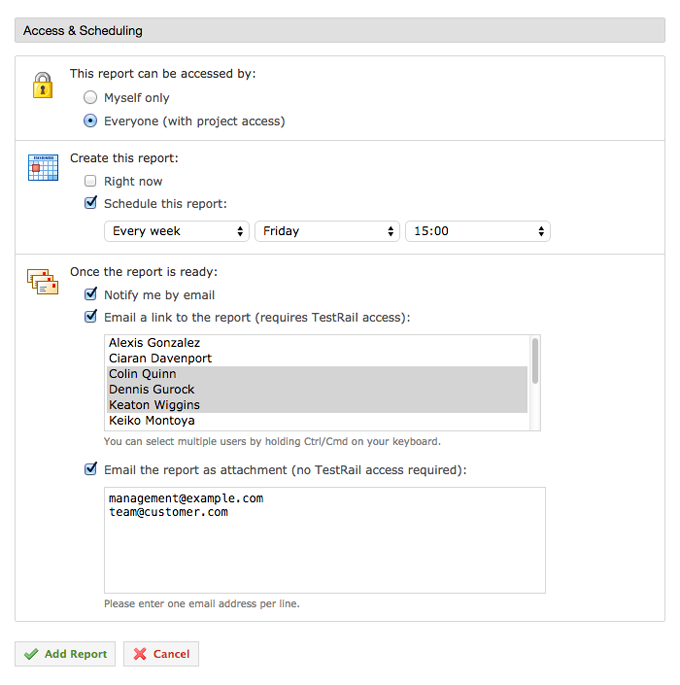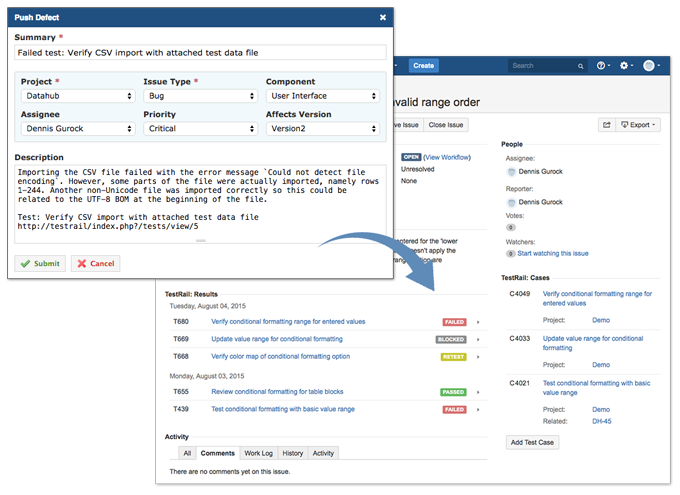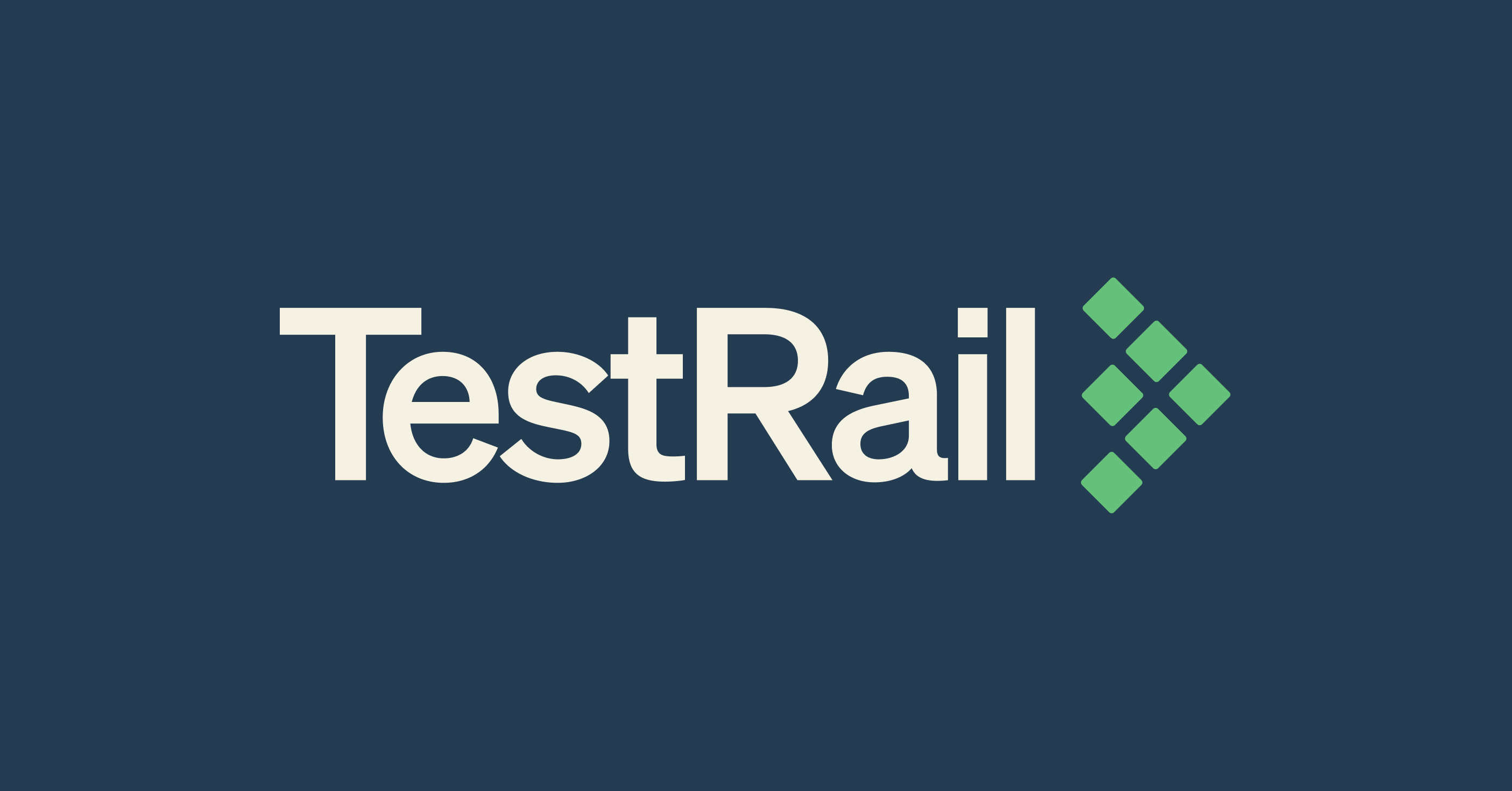Why should we choose TestRail? This is a question we routinely receive from customers who are just about to start their trial of our modern test management tool. It’s a fair question to ask! There are many test management tools available, and why should TestRail be the best fit for their need? Fortunately, in many cases once teams try TestRail and experience its fast and modern user interface, as well as TestRail’s many unique features that help teams work faster and more efficiently, teams quickly understand the advantages TestRail brings to the table. In this article we are going to highlight some of TestRail’s unique productivity features that will help your team save many many hours every week compared to other test management tools.
The number #1 reason teams switch to TestRail is the significant increase in productivity teams get by adopting TestRail, as well as the resulting time, resource and cost savings. We receive this feedback from users all the time and teams often tell us that they spend a lot of time in a test management tool every day, so TestRail makes a huge difference for them. Many teams migrate to TestRail every week from all kinds of tools. This includes legacy ALM systems, JIRA add-ons and all kinds of open source and commercial test management tools.
Does tool productivity really matter? If you value the time and resources (and related costs) of your testing team, productivity and efficiency should be your number one priority when selecting a test management tool. Engineers, developers and testers cost huge amounts of money every month, so you want to make sure you give them the best tools available to get the job done.
If you consider TestRail’s many productivity features combined with unique capabilities such as its deep JIRA/issue and test automation integration, rich reporting & metrics, important enterprise and customization options and much more, as well as very competitive pricing, it’s easy to see why many teams adopt TestRail. Make sure to review the below feature highlights when comparing TestRail with other tools, it will have a big effect on your team!
Table of Contents
- 1. Three-Pane FastTrack Interface
- 2. Integrated Keyboard Shortcuts
- 3. Drag & Drop plus Screenshot Support
- 4. Test Report & Metrics Automation
- 5. JIRA & Issue Tracker Defect Push
- 6. Test Plans & Platform Configurations
- 7. Bulk Editing Cases & Adding Results
- Is TestRail Right For Your Team?
1. Three-Pane FastTrack Interface
TestRail’s three-pane FastTrack view allows you to see your section list, list of test cases and the details of the selected test side by side. This view is incredibly productive as it allows you to quickly open a test, review the test steps, add a result and jump to the next test. All this without navigating to another page, switching contexts or moving to another section. The three-pane view is fully integrated into TestRail and is available from any test run or suite page. Simply select a test case via the arrow icon to expand the view and see all test details at a glance.
The view also integrates all features known from the test and case pages, so you can easily add results, comments and review related details. And best of all: with TestRail’s new responsive layout improvements, and separately configurable columns, you can also use and benefit from TestRail FastTrack if you have a smaller display.
 TestRail FastTrack: incredibly productive three-pane view for faster testing
TestRail FastTrack: incredibly productive three-pane view for faster testing2. Integrated Keyboard Shortcuts
With TestRail 4.2 we also added integrated keyboard shortcuts for often used features so you can more easily save test cases & forms, add new test steps, jump to the next test or add test results. TestRail supports shortcuts you are most likely already familiar with from other applications, so you can save your test case changes via Ctrl+s, edit most entities by pressing e or navigate between tests via j and k. Please refer to our our detailed overview of key shortcuts we support in TestRail.
For TestRail’s unique FastTrack interface we also introduced another related productivity feature: we now support a single key press shortcut to mark a test as passed and directly select and load the next test as part of TestRail FastTrack. To support this, we added new Pass & Next actions, along with additional quick action buttons for other test results. Likewise, we added various additional keyboard shortcuts to make it even faster to navigate between test cases, open the Add Test Result dialog, toggle the three-pane view and add comments.

Add test results & jump to the next test with a single mouse click or key press
3. Drag & Drop plus Screenshot Support
With TestRail 5.2 we also added full support for drag & drop to make it very fast to add files and images to your test case, text fields and test results. To drag images, screenshots or any other file to TestRail, simply drag the file from another application or Windows Explorer/Mac Finder to TestRail. Depending on the page you are on, TestRail will automatically show all valid and available drop targets, so it’s easy to attach all kinds of files to test cases, or directly embed images in any Markdown enabled text field.

Full drag & drop support for files and images with full screenshot integration
But we didn’t just want to make it easier to add images and attachments via drag & drop. Modern web browsers such as Google Chrome and Microsoft Edge are slowly adding better support for copy & pasting images. So TestRail 5.2 introduced the first web-based test management support to make it much easier to paste images into TestRail’s Markdown-enabled text fields, as well as the Add Image dialog (Google Chrome for now). For example, simply select any text field in TestRail, such as the steps field or test result comment, and paste an image. TestRail will then automatically upload the image and add the related inline Markdown code to display the pasted image in the field.

Fast adding of images and screenshots via copy & paste to any of TestRail’s text fields
4. Test Report & Metrics Automation
Adding more useful built-in reports that help our customers answer important questions about their testing efforts and help teams make informed decisions during development was a major design goal of TestRail 3.0. Making it as easy and flexible as possible to run, schedule and share said reports is equally important, so we added a bunch of useful options for this. TestRail allows you to generate new reports on a pre-defined schedule so you can, for example, automatically generate new reports once a day or once a week so your team or project stakeholders get fresh reports automatically.

Schedule and automatically generate & forward reports on autopilot
TestRail also makes it extremely easy to share reports with both TestRail users as well as external stakeholders such as customers. Besides hosting and displaying reports inside TestRail, you can also forward reports as HTML attachments via email or download reports to archive them. Combined with the above mentioned scheduling feature you can keep your entire company updated on your latest testing efforts automatically and run your reporting on autopilot, awesome!
5. JIRA & Issue Tracker Defect Push
TestRail’s deep JIRA and other issue/defect tracker integration makes it super productive to link test cases to requirements and user stories, link test results to defects and bug reports, directly look up details of linked issues and run detailed coverage reports. One of the most useful features of our integration is that you can directly push bug reports from TestRail to JIRA and a dozen of other tools. Has one of your testers found an issue during testing? Easy! Simply push a bug report to your team’s issue tracker with just 1 click.

Directly push bug reports & defects from test results to JIRA and a dozen other tools
But the integration doesn’t stop here: TestRail automatically remembers all relevant settings such as the issue tracker project, issue type, component, bug priority and other attributes of your issues on a per-project basis. So when a tester pushes another bug report from the same project, all settings are automatically restored for even faster bug creation. With TestRail’s deep JIRA and issue tracker integration there’s no need to synchronize any bug reports or store bug reports in multiple places: TestRail always directly integrates with your existing tools.
6. Test Plans & Platform Configurations
A very typical use case for many testing teams is the requirement to run their tests against different platforms and configurations. This can include different web browsers, operating systems, mobile devices, specific hardware platforms or a combination of any of these. Many testing tools make such tests very time consuming or even impossible to run. Not so with TestRail’s extensive test plan and configuration features! Test plans make it super easy to run your tests against all kinds of configurations and platforms with just a few clicks: check out the video.

Create extensive test plans with automatic test run creation for configurations
You only need to configure your project configurations once and can easily reuse all configurations across test plans. TestRail automatically creates new test runs for each selected configuration combination. Want to create separate runs for all your supported web browser, operation systems, mobile devices, all relevant combination and assign them to different testers? It just takes a few clicks with test plans & configurations! Test plans & configurations help you and your team save many hours with planning, running and reporting your software tests.
7. Bulk Editing Cases & Adding Results
TestRail also includes powerful options to bulk edit your test cases to update any of the case attributes with a single click. Whether you want to change the preconditions of all test cases in a section, update the type of your cases in an entire suite or carefully filter and change the priority of thousands of cases at once: the bulk-edit feature makes this super easy.

Bulk edit test cases and add test results to many tests at once with a single click
You can either select the test cases you want to update manually, or you can use the bulk-edit feature together with our powerful filtering options. But bulk operations are not just limited to editing cases. You can also move, copy and delete many test cases at once so you can better organize and refactor larger projects. You can also easily add results to many tests in a run and assign many tests or entire sections to different testers with a few clicks, saving you a lot of time when planning, assigning and running your tests.
Is TestRail Right For Your Team?
Many thousand companies are using TestRail to supercharge their software testing, including many of the world’s largest and most successful organizations. And many new teams are starting to use TestRail every week. Should your team switch to and adopt TestRail as well?
A big reason so many teams of all sizes with all kinds of development methodologies switch to TestRail is that all teams have one thing in common: every team is looking for the one tool that helps them work as efficiently as possible. So the chances are very good that TestRail would be a great fit for your team as well, and you should at least give it a try with our free 30 day trial. It only takes a few minutes to get started!



